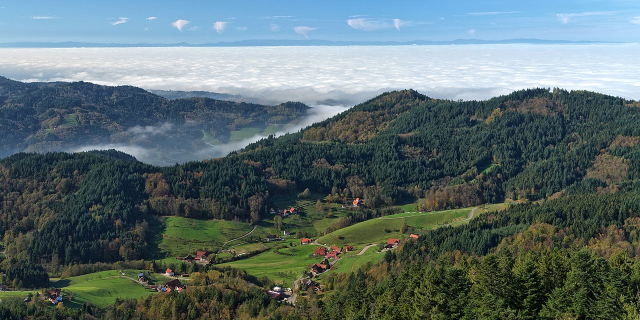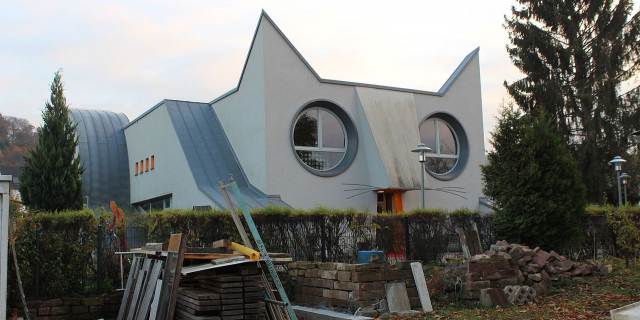Ouvrage Schoenenbourg is a Maginot Line fortification. It is located on the territory of the communes of Hunspach, Schœnenbourg and Ingolsheim, in the French département of Bas-Rhin, forming part of the Fortified Sector of Haguenau, facing Germany. At the east end of the Alsace portion of the Maginot Line, its neighbour is the gros ouvrage Hochwald. It is the largest such fortification open to the public in Alsace. Officially recorded as an historical monument, it retains all its original structural elements. Schoenenbourg was heavily bombarded during the Battle of France in 1940, receiving more enemy ordnance than any other position in France, with no significant damage. In 1945, retreating German troops used explosives to destroy much of the ouvrage. After the war it was fully repaired and placed back into service as part of a programme to us...Read more
Ouvrage Schoenenbourg is a Maginot Line fortification. It is located on the territory of the communes of Hunspach, Schœnenbourg and Ingolsheim, in the French département of Bas-Rhin, forming part of the Fortified Sector of Haguenau, facing Germany. At the east end of the Alsace portion of the Maginot Line, its neighbour is the gros ouvrage Hochwald. It is the largest such fortification open to the public in Alsace. Officially recorded as an historical monument, it retains all its original structural elements. Schoenenbourg was heavily bombarded during the Battle of France in 1940, receiving more enemy ordnance than any other position in France, with no significant damage. In 1945, retreating German troops used explosives to destroy much of the ouvrage. After the war it was fully repaired and placed back into service as part of a programme to use Maginot fortifications to resist a potential Warsaw Pact advance through Europe. By the 1970s the plan had lost favour and funding, and Schoenenboug was abandoned. In 1987 a local organisation undertook Schoenenbourg's preservation, and today it is open to public visitation.
The fortification at Schoenenbourg is the one that saw the most combat between September 1939 and June 1940. Over this period, over 17,000 shells were fired from the fort, and it was itself the target of over 3000 shells and 160 bombs. Schoenenbourg was in action against the German 146th Infantry Division, which applied pressure along the Line.[1] On 19 June 1940, German Stukas attacked Schoenenbourg and other ouvrages, returning on the 20th and 21st. The attacks on the 21st were joined by a bombardment with 420 mm siege mortars, lasting three days. The bombardment cracked walls, but did not disable the position.[2] Schoenenbourg fired during this period in support of nearby casemates, not seriously affected by the bombardments. Schoenenbourg's turrets were retracted to receive the heavy shells, and raised during the lengthy reloading period for counterbattery fire. The inventory of German ordnance fired against Schoenenbourg was assessed after the armistice, and found to comprise 160 aerial bombs, 50 42 cm shells, 33 28 cm shells, and approximately 3000 smaller projectiles,[3] the most ammunition used against any fortification in France.[4] The final surrender of Schoenenbourg was effected on 1 July 1940, in accordance with the terms of the Second Compiègne armistice.[5][6][7] Following the surrender Schoenenbourg was used as a backdrop for propaganda films and as an indoctrination center for Hitler Youth.[8]
1945No fighting took place in the area of Schoenenbourg during the American advances of 1945, but the retreating Germans of the 245th Infantry Division caused extensive damage in March, using explosives to wreck the entrances and turrets, along with a number of nearby casemates. The U.S. 36th Infantry Division took possession of the damaged ouvrage on 20 March 1945.[7][9]
Cold WarIn the 1950s interest in the Maginot Line was renewed. In 1951, Lembach, Four-à-Chaux, Hochwald and Schoenenbourg were designated the Môle de Haguenau, a point of resistance against a potential invasion by forces of the Warsaw Pact. Lembach was repaired and put in a state of readiness in 1951–52. Wartime damage was repaired. The reconstructed entries took on a form that was modified from the original design, using the old foundations.[10] By the late 1950s interest in fixed fortifications was waning after France developed a nuclear deterrent. The money needed to maintain and upgrade the fortifications was diverted for the nuclear programs. Schoenenbourg was not manned or maintained after the early 1970s[7][11][12] The gallery system was used by the army for training until 2001, and the surface hosted three field emplacements for anti-aircraft missiles.[13]


































Add new comment